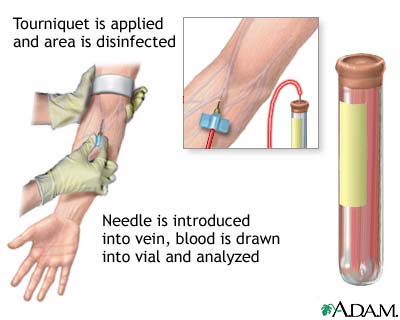Although prostate cancer is considered a disease of the elderly man, it has been known to inflict its damage on men in their early 30s. Heredity seems to play a factor especially in younger patients.
If you're a man over 50, you should consider a yearly Prostate cancer PSA (Prostate Specific Antigen) test. It's a simple a blood test that can help doctors catch the very early cases of prostate cancer. This is a great way to protect yourself from this potentially deadly disease that afflicts men in their later years.
Let me caution you that an elevated PSA result can be caused by a variety of factors and does not necessarily indicate prostate cancer. These other causes include BPH or benign hypertrophy or enlargment of the prostate, and also elevate the PSA test results. Even Prostatitis and Lower Urinary Tract symptoms can show elevated levels of PSA.
The prostate specific antigen test is like any other simple blood test. Blood is drawn by a phlebotomist and sent to the lab for analysis. A normal result from a PSA test, doesn't guarantee that your free from cancer, nor does a higher than normal result mean you DO have cancer

A PSA Count of between 0 - 3.9 nanograms per milliliter of blood is generally considered normal. Levels higher than a 3.9 ng count may indicate there may be a prostate problem which could be anything from a swelling or inflammation, infection or cancer.
It's critical that you follow your doctor's lead in regard to dealing with the Prostate Specific Antigen test results. The results are an indication that something may be happening only. To complicate matters even more, PSA levels can also increase with age. Oh and the relative size of your prostate also plays a factor in interpreting the results.
The point of this is the strongly encourage you to have an annual prostate exam and PSA blood test.
Please do not assume a high PSA reading means that you have prostate cancer. All a high PSI level reading indicates is that there "may" be a problem. Two out of three people with elevated the PSA readings DO NOT have a malignancy. So don't panic!
Here's a few very good reasons why you should consider getting an annual PSA blood test
a. Your doctor is much better able to detect potential prostate cancer even though you have no symptoms.
2. Early detection means a much higher chance of successful treatment and cure
3. The PSA blood test is simple and is recognized as a major contributing factor in the continued drop of prostate cancer deaths

So what we know as patients about the PSA test is that it's not perfect and cannot clearly identified the presence of prostate cancer. All the tests provides is an indicator of a potential benign or cancerous prostate problem
We also know that the term 'normal" in dealing with the PSA test result is subject to interpretation due to many factors. This is why it's critical that your doctor interpret the results.
The PSA test indicated a normal antigen level in about 20% of the cases in men who had early prostate melanoma.
Even with an imperfect test however, it's recognized that the PSA is a good indicator and tool in our arsenal to fight this deadly disease. Note that a Harvard study done in 2005 indicated that those men having a yearly PSA test and monitoring of PSA levels were almost 3 times less likely to die for prostate cancer than those who didn't bother with the PSA
Finally, according to the Centers for Disease Control ( CDC ), is the introduction 20 years ago of any use of the PSA test, deaths from prostate cancer have fallen by one third. Prostate cancer if caught in its early stages is treatable and curable. Don't wait until it is too late to have this important test done







